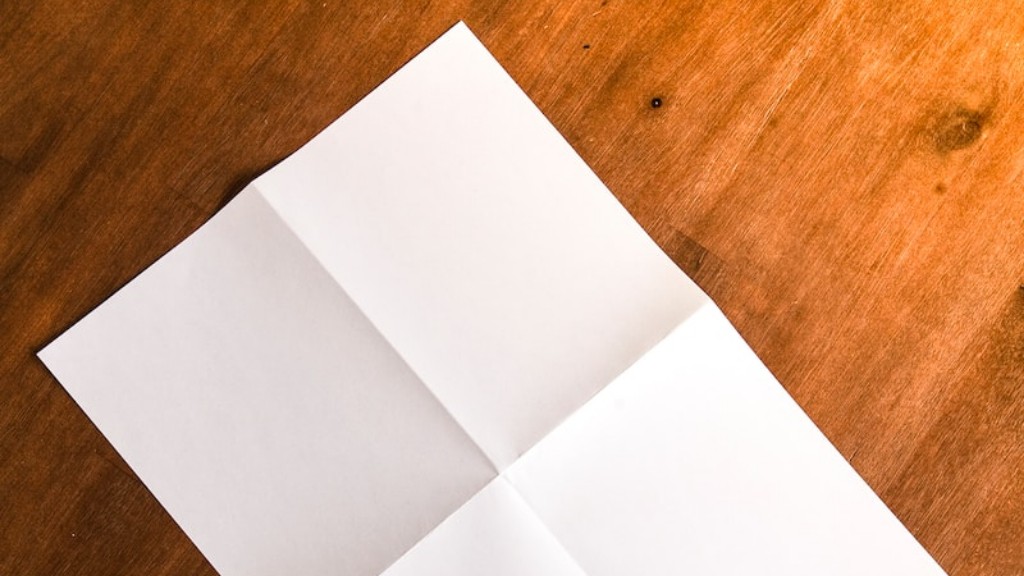Printer paper is a common sight these days in home offices, businesses and schools. From handwritten letters to classroom projects, it seems like users of printers can never have enough of it. But how big is printer paper actually?
To answer this, it’s important to define what is meant by “big”. In the context of paper, size typically refers to the length and width. There are two standard sizes for printers used today: Letter-size paper (8.5 by 11 inches) and Legal-size paper (8.5 by 14 inches). The majority of printers are designed to accommodate these two sizes, although some specialty printers are configured for larger sizes.
In addition to width and length sizes, printer paper is also separated into categories for labels, cards, envelopes and banners. Each type of printer paper is designed differently to accommodate the variety of printing needs. For example, labels are designed to fit specific address labels, while banners are designed to be longer for larger printouts.
Printer paper is also categorized by weight. Printer paper weight typically ranges from 16–20 lbs. (pounds), and the weight is related to how thick the paper is. Heavier weight paper is better suited for higher levels of printing quality or more frequent use, such as for business letters, postcards or brochures. Lighter weight paper, on the other hand, is more suited for casual printing needs, such as for printing documents or photos.
When deciding which type and size of printer paper to use for a particular project, there are several things to consider. Firstly, consider the purpose of the project in order to determine whether you need to use heavier or lighter paper. Secondly, consider the size of the document or picture you need to print; larger documents require bigger paper and vice versa. Lastly, take into account the type of printer you are using and make sure that the paper size you choose is supported by the printer.
Different cultures and regions of the world may also have their own specific sizes and types of paper, so it’s important to be aware of these when printing abroad or shipping documents or packages internationally. In North America, for example, Letter-size paper is most commonly used, while in Europe A4 paper is the most widely used size.
Printer Paper Formats
Printer paper also comes in a wide range of formats, from plain white to multicolored or textured paper. Plain white paper is the most widely used, as it provides a clean blank space for printing. Other formats such as glossy or matte finish paper are used to make images or text stand out and look more professional. Textured paper may also be used for a more artsy look.
Printer paper formats also vary depending on the type of printer you are using. Laserjet printers, for instance, use toner-based paper which is hotter and thicker than regular paper and is designed to stay in shape once printed. Conversely, inkjet printers use heavier and thicker paper to help absorb the ink and to prevent it from smudging.
When selecting printer paper, it is also important to take into account the end use of the document being printed. For example, documents that need to be kept for a longer period of time or that will be handled frequently, such as reports or presentations, may require a thicker or higher quality paper that will resist wear and tear.
Ink and Toner Consumption
The size and type of printer paper can also have an effect on the amount of ink or toner used by the printer. Heavier papers, such as card stock or glossy finish paper, require more ink or toner than plain white paper. Additionally, thicker papers may also cause the printer to jam or smudge more easily.
In order to save on ink or toner, it is best to choose paper in the correct size and weight for the project. Using paper that is too heavy or thick will not only require more ink or toner, but can also damage the printer due to jams or smudging.
Printer paper that is specifically designed for a particular printer can also help to reduce ink or toner consumption. Such papers are often made with special coating or textures to enhance the print quality, thus reducing the amount of ink or toner required. Additionally, some printer manufacturers produce paper specifically designed for their printers to reduce paper jams and maximize ink and toner efficiency.
Environmental Impact
When selecting printer paper, it’s important to consider any potential environmental impact. Printer paper is mostly made of wood pulp, a type of material that is not easily or quickly biodegradable. In addition, the production of printer paper involves the usage of large amounts of water and energy, and the use of toxic chemicals in some cases.
However, printer paper can be recycled or reused whenever possible. Recycled paper contains fewer virgin fibers and is made from recycled materials, thus helping to reduce the environmental impact of its production. Additionally, printing on both sides of the paper can also help to reduce paper usage.
For those who want to be more conscious about their environment, there are a variety of printer papers that are available that are made from sustainable sources such as cotton, bamboo, or kenaf. Such papers are also available in different sizes and weights, and can be a great way to reduce environmental impact while still performing printing tasks.
Conclusion
In conclusion, printer paper comes in many sizes and weights, and it is important to choose the right one for a particular need. Additionally, it is important to take into account environmental factors when selecting printer paper, and to make sure to recycle or reuse paper whenever possible. By taking these considerations into account, printer users can make sure that they are choosing the right type of paper for their printing needs.




